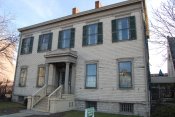
Sibley House stands at 976 East Jefferson Avenue in Detroit, next to Christ Church, Detroit. Exterior restoration is complete, but a fund must be established to secure a State of Michigan Historical Marker and ensure the future restoration of this valuable historic landmark.
Completed in 1848, the Greek Revival residence was home to generations of Sibley family members. Judge Solomon Sibley, Detroit’s first mayor, visualized the plans for his third Detroit residence, but, sadly, died before the house was completed. His widow, Sarah Whipple Sproat Sibley, and two unmarried daughters moved in. Sarah Alexandrine Sibley was the last member of the family that resided in the house. She died in 1918.
There is much to be admired about the Greek inspired elements of the house. Three stories with a symmetrical front façade and a central columned entrance that faces East Jefferson Avenue, its lines are graceful. Some of the windows still have the old pleated panes of glass creating a wavy effect as one looks out.
In the late 1840′s when the Sibley House was being constructed, a view of the Detroit River and its passing parade of ships was appreciated, and for this reason, a two-story porch was added in addition to a second main entrance at the rear of the house.
Perhaps, the most unusual feature of the house is the hanging switchback staircase, thought to be the only one of its kind, still in existence, in Detroit. It is considered to be “hanging” because it was built from the top rather than the bottom. The story that has been passed down from generation to generation claims that ladies of another era had difficulty negotiating their large hoop skirts as they descended the staircase.
The Sibley House parlor is also alleged to have the first piano transported west of the Allegheny Mountains!
During its 168 year old history, the Sibley House and the Sibley family has contributed in numerous ways to enhance the lives of Detroiters and still stands as a tribute to our great city. Utilized in two World Wars to house relief organizations, opened several times as a neighborhood welcoming center, housing for a veteran and his family, and as a rectory for Christ Church, this house has long stood as a symbol of the spirit of Detroit and as a beacon of hope.
Although the exterior restoration is completed, and the house is the newest “Jewel on Jefferson,” funding still needs to be secured to pay the expense of a State of Michigan Historical Marker which will grace the front yard. It will inform passersby of the historical importance of the third and final home built for Detroit’s first (appointed) mayor.
In the past, the house has been open to the public for tours, but as it now contains the offices for Christ Church, Detroit, it is generally not open to visitors. However, Christ Church, Detroit is one of the churches, regularly scheduled, through the Historic Houses of Worship tours provided by the Detroit Historical Society.
Designated a Michigan State Historic Site in 1958, included on the National Register of Historic Places in 1971, and it was recorded in the Library of Congress as a distinguished American building in 1934.
Email The Sibley House Fund at: sibleyhousedetroit@christcd.org if you are interested in more information about the recently completed restoration and/or if you wish to help raise the dollars needed for the State of Michigan Historical Marker. The house has a Sibley House Fund, and this house fund will be used for the historical marker costs and as a funding source for future repairs. It is a designated 501(c) 3 non-profit fund.
Donate Now! feature is also available on this site.
